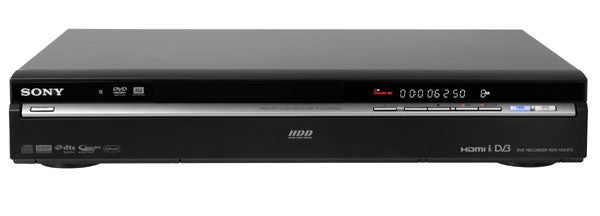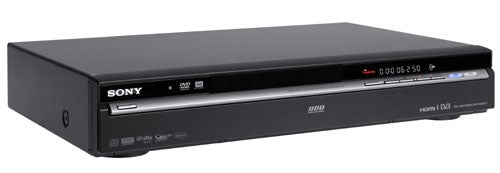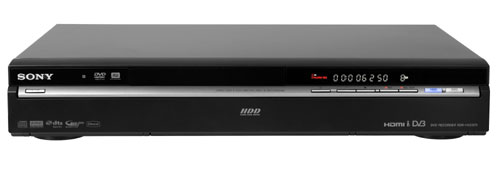Sony RDR-HXD870 Digital Video Recorder Review
Sony RDR-HXD870 Digital Video Recorder
Sony has thrown everything into this recorder - you could probably even use it for the washing up!

Verdict
Key Specifications
- Review Price: £211.88
Not that we’re complaining, but it seems as though big-name brands like Sony and Panasonic are engaged in some sort of competition to see who can cram the most features into their digital recorders.
Just recently we posted a review of the Panasonic DMR-EX77, an astonishingly well-specified HDD/DVD combi which counts 1080p upscaling and DVD-Audio playback among its many features.
Well, Sony has seen Panasonic’s bet and raised the stakes with the RDR-HXD870, a 160GB hard-disk/DVD recorder combi with even more fancy functionality than its Panasonic counterpart.
It features a digital TV tuner, and with the exception of DVD-RAM it will record onto any recordable DVD disc format, including dual-layer DVD+R and DVD-R discs.
But the main feature that sets the Sony apart from its rivals is Series Recording, which as the name suggests will record every programme in a series using information provided by Freeview.
It’s similar to Series Link, one of Sky Plus’ most compelling features, making its appearance here highly significant. The HXD870 will additionally recognise when a programme has been split (to accommodate the news, for example) which makes it even more flexible.
But focusing on this feature is like reviewing a Ferrari and only talking about its wing mirrors – there’s tons of other exciting stuff elsewhere. Not least the deck’s 1080p upscaling capabilities, which lets you boost the resolution of DVDs as well as your own recordings. Yes that’s right – after all these years you can finally watch Gardener’s World in 1080p.
Connections are hugely generous by digital recorder standards. Aside from the HDMI output (which also offers 720p and 1080i), you get component video, two Scarts (offering RGB input and output) and a coaxial digital audio output for piping Dolby Digital and DTS soundtracks to your amplifier.
But around the front things get even more interesting. It sports a USB port, which allows you to plug in a flash drive and transfer MP3 and JPEG files to the hard-disk, where they can be organised, edited and played using the Jukebox and Photo Album features. You can even copy images on the HDD to DVD-R or DVD-RW discs, and should you feel the urge to print out any of your pictures you can hook up the PictBridge socket to a compatible printer and do so – a rare but very welcome feature.
The front panel also sports an iLink (FireWire) input primarily intended for transferring DV camcorder footage. It’s an input only, so you can’t transfer edited footage back to the camcorder.
Also onboard is a staggering array of recording and editing features. Unlike most digital recorders, which offer a range of about five or six recording presets, the Sony offers 34 quality settings, allowing you to record in bitrates ranging from 0.75Mbps to 15Mbps (the latter used by the HQ+ mode, which offers better-than-DVD recordings from DV camcorders). But to make things easier, there’s also a choice of nine presets.
Depending on which of these recording modes you use, it’s possible to fit between one and 17 hours on a dual-layer disc, or up to 340 hours of TV on the hard disk, which even Jim Royle would have trouble filling.
After you’ve made your recordings, you can delete chunks of them using A-B Erase, or divide and combine chapters. If you’re using the HDD or DVD-RW/-R discs formatted in VR mode, the Playlist feature allows you to piece together sequences of clips without affecting the original recordings. Recordings or edited playlists can be copied from HDD to disc (or vice versa) at up to 6x speed, depending on the disc type.
Despite its vast array of functions, the HXD870 is easy to set up and its features can be mastered quickly thanks to the intelligently designed user interface and remote. The deck is slick and responsive, and the menu screens are not only practical but attractive too – the Title List screen features moving thumbnails, for example.
The Freeview EPG is also easy to use. It’s laid out in a Sky+ style grid, making it simple to set timer recordings. It’s backed up by superb Now and Next banners, which can be called up while watching a programme to check what’s on the other channels – not all Freeview recorders allow you to do this.
The only let-down from an ease of use perspective is the Guide Plus EPG, designed to bring Freeview-style channel navigation to the analogue TV domain. It’s sluggish, counter-intuitive and a pain to setup, so thank goodness you can set the timer manually.
To test its picture prowess, we hooked the Sony up to a Hitachi 1080p-capable plasma via HDMI and we were blown away by the results. Pictures from the built-in Freeview tuner are sharp, colourful and clean (provided you’re tuned into a decent-quality channel like BBC News 24), and generally free from noise and other MPEG-related anomalies.
This translates into excellent hard-disk and DVD recordings. In HQ mode, recordings of Without A Trace on Channel 4 look identical to the live broadcast, with high amounts of colour and detail, plus solid black levels. There’s also a pleasing lack of MPEG block noise or shimmering, even during fast-moving action.
In fact, it’s only when you drop down to SP and LSP mode that you notice any difference between live and recorded picture quality. Some areas of the picture exhibit some twitching and pulsing on large coloured areas (particularly when shadows are involved) but overall the quality is still exceptionally good. The good news is that LSP offers longer recording times at the full DVD resolution of 720 x 576 pixels.
The lower-quality ESP and LP modes use a resolution of 544 x 576, and despite looking a touch softer the results are still eminently watchable. However, the low-bitrate EP, SLP and SEP modes look soft and unnatural, so it’s best to reserve them for emergency use only.
The deck’s upscaling is hugely impressive, boosting DVD and TV pictures to 720p, 1080i and 1080p without introducing any artefacts into the picture. Don’t expect miracles when watching TV recordings in 1080p though – it’s not quite the detail boosting revelation you might expect (the deck can’t add detail that isn’t already there) but because the signal is kept in the digital domain, programmes look crisper and cleaner than ever before.
1080p upscaling comes into its own with The Departed on DVD. The excellent black level and impeccably presented detail make Scorsese’s blistering cop drama look effortlessly rich and cinematic. Motion is smooth, and there are no pesky MPEG artefacts to spoil the image clarity.
We had no trouble playing back DivX files on the Sony, but we were disappointed by the lack of WMA support.
Audio performance is impressive. Hooked up to a good home cinema system, Dolby Digital and DTS soundtracks are clear and dynamic, while stereo CDs sound better than we expected through the analogue audio outputs. Tricky jazz tunes like Miles Davis’ Blue In Green sound surprisingly well-balanced and uncoloured.
”’Verdict”’
The RDR-HXD870 is a magnificent hard-disk/DVD combi recorder that boasts a staggering array of features (including the all-important Series Recording) and killer performance. But the biggest bonus is the price – at just over £200 it’s much more affordable than its spec sheet would suggest, making it a real bargain to boot. Given Sony’s usual ‘pricier than thou’ attitude, this deck makes a refreshing change.
Trusted Score
Score in detail
-
Performance 9
-
Features 9
-
Value 10

